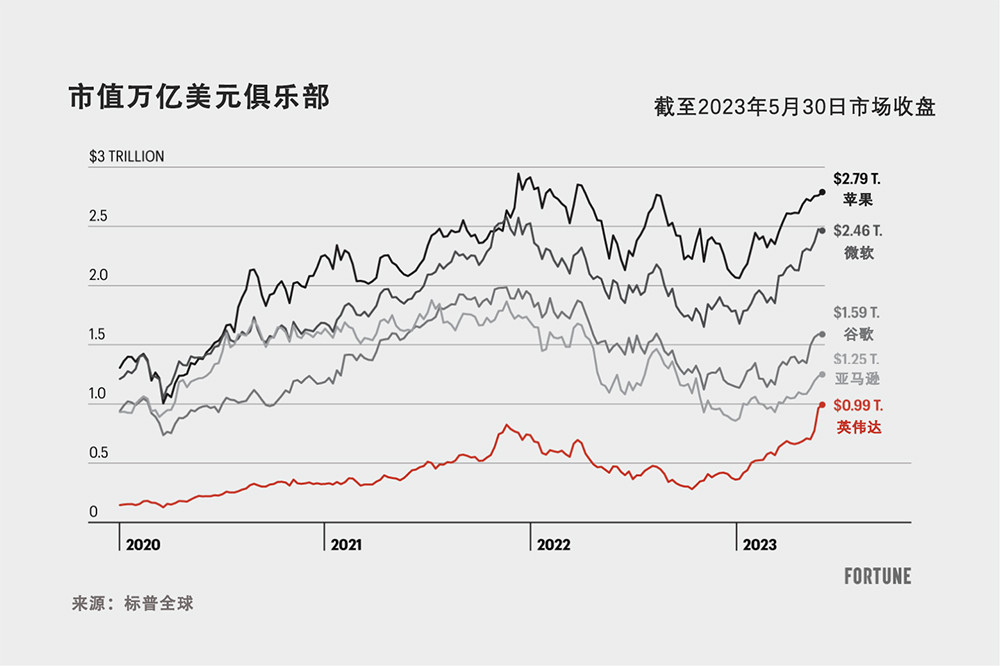5支股票贡献了今年96%的标普500涨幅,包括英伟达

周二,英伟达(Nvidia)一度跻身万亿美元俱乐部(Trillion-Dollar Club)的高市值公司行列,随后股价小幅下跌。
5月30日,英伟达首次跻进1万亿美元顶级俱乐部,因而抢占了各大商业头条。自5月15日以来,这家人工智能(AI)软硬件制造商和设计公司迎来了重要的里程碑:估值上涨了惊人的2800亿美元,涨幅将近达到40%,这个几乎不可能取得的成就在资本市场史册上是空前的(收盘时其涨幅略低于40%关口)。
但英伟达市值的暴涨也有其阴暗面。今年,万亿美元俱乐部所有成员的市值均大幅飙升,英伟达的表现就是这个史诗级现象的缩影。事实上,这5个目前估值达到14位数字的成员几乎快要吞噬了标准普尔500指数(S&P 500 index)。这并不是一件好事。这几支股的一致上涨是今年提振该大盘指数的唯一力量。而由于这些企业在近期起飞后本就高昂的股价被推至更高,今后仅依靠这不足6支的股票是不大可能支撑市场走高的。最有可能的是,它们的估值已经超出了上限,将来势必会反弹。英伟达的崛起就是万亿美元俱乐部存在泡沫的最佳例子。
万亿美元俱乐部贡献了标准普尔500指数今年几乎全部的涨幅
万亿美元俱乐部现在的成员有苹果公司(Apple)、微软(Microsoft)、谷歌(Google)母公司Alphabet、亚马逊(Amazon)和英伟达(自周二中午起)。从1月至5月,该俱乐部成员的市值均上涨了三分之一以上,其中苹果公司股价涨35%,微软涨39%,Alphabet涨41%,亚马逊涨43%,英伟达涨176%。过去5个月里,苹果公司和微软的市值各自增长了7000亿美元,其次是英伟达(6400亿美元)、Alphabet(4600亿美元)和亚马逊(3710亿美元)。自2023年初以来,万亿美元俱乐部目前所有成员的市值总和增长了2.87万亿美元。
问题在于,该大盘指数的总增长值仅略高于这个数值,为2.98万亿美元。因此,本年度截至现在为止,万亿美元俱乐部贡献了标准普尔500指数9.5%涨幅的96%。让我们把该俱乐部想象成一家公司,姑且称其为五大公司(Big Five Ltd)。这家公司的估值从6.2万亿美元飚升至9.1万亿美元,涨幅达到46.2%。相比之下,500股中的另外495股的总涨幅仅为0.3%。简单来说,如果没有万亿美元俱乐部的巨大提振,标准普尔500指数今年将会持平,而不会录得华尔街吹捧为强劲回升的表现。
万亿美元俱乐部的巨大影响力使标准普尔500指数失去平衡
截至2022年底,当前的万亿美元俱乐部估值占标准普尔500指数总估值的17.6%,相当于六分之一左右。如今,这一数值达到25.6%,相当于超过四分之一。随着市值增长近3万亿美元,也就是整体市值上升近一半,五大公司的股价远高于此前的水平。五个月里,它们的整体市盈率(由总估值除以合并净收益得出)从27.7倍攀升至40.6倍,这意味着,与2022年圣诞节期间相比,投资者现在每投资100美元的收益减少了33%。顺便说一下,五大公司目前40多倍的市盈率几乎是标准普尔500指数整体市盈率23倍的两倍。
这尤其令人不安,因为自疫情爆发以来,万亿美元俱乐部已经创造过某种盈利奇迹。2022年,五大公司的净利润总和约为2240亿美元,比2019年疫情前高出50%。因此,现在的高倍数市盈率建立高利润的预期之上,而高利润却不大可能持续。
突然之间,投资者们就开始预期四家已然十分庞大和成熟的公司(苹果公司、微软、Alphabet和亚马逊)将会实现极快速度的盈利增长,并且因为对AI抱有过高的期望而指望英伟达取得飞速增长。无论是期望,还是股价,都太高了。重点是,英伟达的崛起表明,随着万亿美元俱乐部科技巨头股价的日益高昂,它们逐渐吞噬了大盘指数的极大份额,从而推动该指数的价格不断上涨。
标准普尔500指数今年的回升只迎来了两声欢呼。万亿美元俱乐部的表现跑赢大盘,而市场上其他股票的表现则反映蹿升的历史市盈率有所回落。不久,该俱乐部也将面临拖累市场上其他股票的下挫压力。当转变来临时,整体指数将承受更大的下行压力。仅靠几个彪形大汉是不可能永远拉动一辆满载累赘的大篷车的。(财富中文网)
译者:中慧言-刘嘉欢
周二,英伟达(Nvidia)一度跻身万亿美元俱乐部(Trillion-Dollar Club)的高市值公司行列,随后股价小幅下跌。
5月30日,英伟达首次跻进1万亿美元顶级俱乐部,因而抢占了各大商业头条。自5月15日以来,这家人工智能(AI)软硬件制造商和设计公司迎来了重要的里程碑:估值上涨了惊人的2800亿美元,涨幅将近达到40%,这个几乎不可能取得的成就在资本市场史册上是空前的(收盘时其涨幅略低于40%关口)。
但英伟达市值的暴涨也有其阴暗面。今年,万亿美元俱乐部所有成员的市值均大幅飙升,英伟达的表现就是这个史诗级现象的缩影。事实上,这5个目前估值达到14位数字的成员几乎快要吞噬了标准普尔500指数(S&P 500 index)。这并不是一件好事。这几支股的一致上涨是今年提振该大盘指数的唯一力量。而由于这些企业在近期起飞后本就高昂的股价被推至更高,今后仅依靠这不足6支的股票是不大可能支撑市场走高的。最有可能的是,它们的估值已经超出了上限,将来势必会反弹。英伟达的崛起就是万亿美元俱乐部存在泡沫的最佳例子。
万亿美元俱乐部贡献了标准普尔500指数今年几乎全部的涨幅
万亿美元俱乐部现在的成员有苹果公司(Apple)、微软(Microsoft)、谷歌(Google)母公司Alphabet、亚马逊(Amazon)和英伟达(自周二中午起)。从1月至5月,该俱乐部成员的市值均上涨了三分之一以上,其中苹果公司股价涨35%,微软涨39%,Alphabet涨41%,亚马逊涨43%,英伟达涨176%。过去5个月里,苹果公司和微软的市值各自增长了7000亿美元,其次是英伟达(6400亿美元)、Alphabet(4600亿美元)和亚马逊(3710亿美元)。自2023年初以来,万亿美元俱乐部目前所有成员的市值总和增长了2.87万亿美元。
问题在于,该大盘指数的总增长值仅略高于这个数值,为2.98万亿美元。因此,本年度截至现在为止,万亿美元俱乐部贡献了标准普尔500指数9.5%涨幅的96%。让我们把该俱乐部想象成一家公司,姑且称其为五大公司(Big Five Ltd)。这家公司的估值从6.2万亿美元飚升至9.1万亿美元,涨幅达到46.2%。相比之下,500股中的另外495股的总涨幅仅为0.3%。简单来说,如果没有万亿美元俱乐部的巨大提振,标准普尔500指数今年将会持平,而不会录得华尔街吹捧为强劲回升的表现。
万亿美元俱乐部的巨大影响力使标准普尔500指数失去平衡
截至2022年底,当前的万亿美元俱乐部估值占标准普尔500指数总估值的17.6%,相当于六分之一左右。如今,这一数值达到25.6%,相当于超过四分之一。随着市值增长近3万亿美元,也就是整体市值上升近一半,五大公司的股价远高于此前的水平。五个月里,它们的整体市盈率(由总估值除以合并净收益得出)从27.7倍攀升至40.6倍,这意味着,与2022年圣诞节期间相比,投资者现在每投资100美元的收益减少了33%。顺便说一下,五大公司目前40多倍的市盈率几乎是标准普尔500指数整体市盈率23倍的两倍。
这尤其令人不安,因为自疫情爆发以来,万亿美元俱乐部已经创造过某种盈利奇迹。2022年,五大公司的净利润总和约为2240亿美元,比2019年疫情前高出50%。因此,现在的高倍数市盈率建立高利润的预期之上,而高利润却不大可能持续。
突然之间,投资者们就开始预期四家已然十分庞大和成熟的公司(苹果公司、微软、Alphabet和亚马逊)将会实现极快速度的盈利增长,并且因为对AI抱有过高的期望而指望英伟达取得飞速增长。无论是期望,还是股价,都太高了。重点是,英伟达的崛起表明,随着万亿美元俱乐部科技巨头股价的日益高昂,它们逐渐吞噬了大盘指数的极大份额,从而推动该指数的价格不断上涨。
标准普尔500指数今年的回升只迎来了两声欢呼。万亿美元俱乐部的表现跑赢大盘,而市场上其他股票的表现则反映蹿升的历史市盈率有所回落。不久,该俱乐部也将面临拖累市场上其他股票的下挫压力。当转变来临时,整体指数将承受更大的下行压力。仅靠几个彪形大汉是不可能永远拉动一辆满载累赘的大篷车的。(财富中文网)
译者:中慧言-刘嘉欢
On Tuesday Nvidia briefly joined its pricey peers in the Trillion Dollar Club before trading slightly lower.
On May 30, Nvidia stole business headlines by reaching the super-exclusive $1 trillion club for the first time. The maker and designer of A.I. hardware and software touched the milestone by raising its valuation an astounding $280 billion or almost 40% since May 15, achieving a moonshot virtually unequalled in the annals of capital markets (it closed just below that mark).
But the Nvidia phenomenon has a dark side. It epitomizes the epic, oversize jump in market cap this year for all members of the Trillion-Dollar Club. Indeed, the five members now sporting 14-figure valuations are virtually devouring the S&P 500 index. That’s not a good thing. Their synchronized surge is the sole force that’s lifted the big cap index this year. And because it’s made enterprises that were expensive before their recent takeoff even pricier, it’s extremely unlikely that they can carry the the markets higher on their fewer than half a dozen shoulders going forward. Most likely, their valuations are already stretched beyond the max, and bound to snap back. And the ultimate example of the froth that’s overtaken the Trillion-Dollar Club is the rise of Nvidia.
The Trillion-Dollar Club accounts for almost all the S&P 500’s gains this year
The Trillion-Dollar Club now comprises Apple, Microsoft, Google parent Alphabet, Amazon, and as of midday Tuesday, Nvidia. From January to May, the group’s members have all gained over one-third in value, with Apple stock rising 35%, Microsoft 39%, Alphabet 41%, Amazon 43%, and Nvidia 176%. Apple and Microsoft each added over $700 billion in market cap in the past five months followed by Nvidia ($640 billion), Alphabet ($460 billion), and Amazon ($371 billion). All told, the Trillion-Dollar Club’s current members have raised their combined market cap by $2.87 trillion since the start of 2023.
The rub is that the total rise in the big cap index is only a hair more, at $2.98 trillion. Hence, the Club contributed 96% of the year-to-date 9.5% increase notched by the 500 this year. Let’s think of the Club as one company we’ll call Big Five Ltd. Its valuation jumped by 46.2%, from $6.2 to $9.1 trillion. By contrast, the other 495 cohorts in the 500 posted a combined gain of just 0.3%. Put simply, without the giant lift from the Trillion-Dollar Club, the S&P would be flat for the year, versus posting what Wall Street touts as a strong comeback.
The Trillion-Dollar Club’s huge weight is making the S&P 500 lopsided
At the close of 2022, the current Club accounted for 17.6%, or around one dollar in six, of the S&P’s total valuation. Today, that number is 25.6%, or more than one dollar in four. In boosting their overall worth by nearly half via adding nearly $3 trillion in market cap, the Big Five have become far more expensive. In five months, their overall P/E—based on their total valuation divided by combined net earnings—has climbed from 27.7 to 40.6, meaning that investors are getting 33% fewer dollars in earnings from every $100 they invest now versus at Christmas of 2022. That current 40-plus multiple, by the way, is almost twice the 23 P/E for the overall S&P 500.
That’s especially troubling because since the onset of the pandemic, the Club has already achieved something of an earnings miracle. In 2022, they Big Five garnered around $224 billion in net profits, 50% more than their pre-COVID, 2019 total. So the big multiple comes on top of what could well be unsustainably high profits.
All of a sudden, investors are expecting extremely rapid earnings growth from four already huge, mature companies—Apple, Microsoft, Alphabet, and Amazon—and incredibly fast growth from Nvidia based on vaunting hopes for A.I. The hopes, and the prices, are just too high. Bottom line: Nvidia’s rise symbolizes that as the tech giants in the Trillion Club got more and more expensive, they made the index pricier and pricier by gobbling such a big share.
The S&P’s comeback this year gets only two cheers. The Trillion-Dollar Club is overperforming, while the rest of the market reflects the reversal of an historic earnings blowout. Soon, the Club will face the same gravitational forces holding back the rest of the market. And when the turnabout comes, it will exert augmented, downward force on the overall index. A few mighty stalwarts can’t pull a caravan loaded with laggards forward forever.













